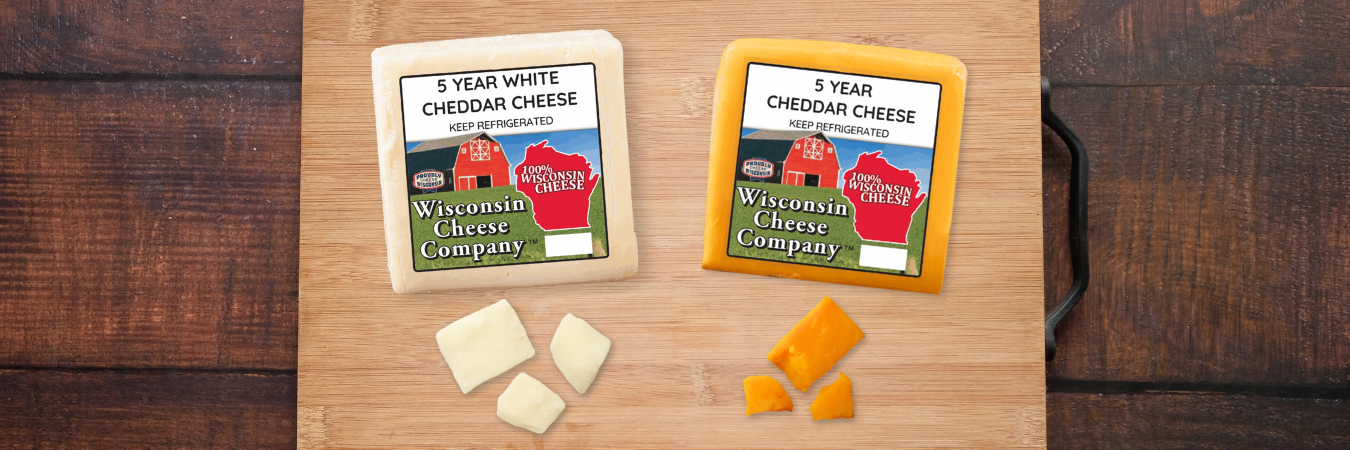
Aged White Cheddar vs Traditional Cheddar: What’s the Difference?
We’re excited to introduce two new additions to our collection: 5-year and 8-year aged white cheddar. If you’re wondering what makes white cheddar different from traditional cheddar, or how aging impacts flavor and texture, this guide will answer your questions and help you discover your next favorite cheese.
What is White Cheddar?
White cheddar and yellow cheddar are made the same way. The key difference is color. White cheddar contains no added color, while yellow cheddar typically includes annatto, a natural food coloring. Without coloring, cheddar retains its natural pale ivory hue.
Why is Cheddar Cheese Yellow? The Colorful History of a Classic
When most people think of cheddar, a rich yellow or orange block comes to mind. But cheddar cheese is naturally white. So how did yellow cheddar become so common?
Cheddar originated in the English village of Cheddar during the 12th century. Traditionally, it was made from raw cow’s milk, giving it a pale cream or off-white color.
Cows grazing on fresh pasture, especially in spring and summer, produce milk rich in beta-carotene, a pigment that gives butter and cheese a slight yellow tint. When English cheesemakers began skimming cream to sell separately, less beta-carotene remained in the milk, and cheddar turned out paler than expected.
Since consumers associated a deeper golden hue with richness and quality, cheesemakers started adding color to maintain that appearance. Annatto, derived from achiote tree seeds, became the colorant of choice by the 18th century. When cheddar made its way to the United States, cheesemakers, especially in Wisconsin and the Midwest, continued this tradition.
Today, yellow cheddar is iconic in America, while white cheddar remains popular in regions like Vermont and the UK. Both varieties are made the same way, and there’s no difference in taste when equally aged. The choice comes down to personal preference and tradition.
The Impact of Aging
Aging is what truly defines cheddar’s character.
- Our 5-year aged white cheddar develops a sharp, rich flavor with hints of nuttiness and a crumbly yet creamy texture.
- Our 8-year aged white cheddar delivers an even bolder, more complex flavor with a crystalline texture that cheddar lovers seek.
Compared to younger cheddars, these aged versions offer depth and intensity, making them ideal for cheese boards, pairing with wine or beer, or enjoying on their own.
Flavor Profile: White vs Traditional Cheddar
While aging is the main driver of cheddar’s flavor, some people feel white cheddar allows the pure flavor of the milk to shine through more clearly, without the visual influence of annatto coloring. In reality, a mild white cheddar and a mild yellow cheddar will taste the same if aged for the same amount of time. As cheddar ages, both develop sharper, richer, and more complex flavors, regardless of color.
Our Full Lineup of Aged Cheddars
In addition to our new aged white cheddar offerings, we’re proud to offer traditional aged cheddar in 2, 3, 5, 8, 10, 12, and 15-year varieties. Each one is carefully aged to bring out the best flavor and texture at every stage.
Final Slice
Whether you prefer aged white cheddar or traditional yellow cheddar, you can trust that every bite of our Wisconsin-made cheddar reflects time-honored methods and exceptional quality.
Ready to try something new? Our 5-year and 8-year aged white cheddar cheeses are available now. Browse our full selection of aged cheddars and find your next favorite.


